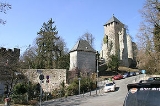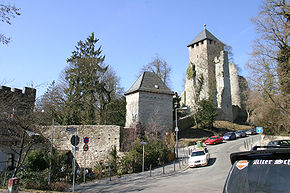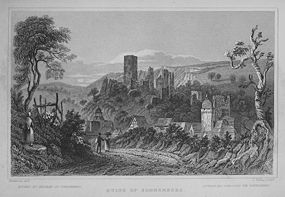
Wiesbaden-Sonnenberg
Encyclopedia
Sonnenberg is a borough
of Wiesbaden
, the capital of the state of Hesse
, Germany
. Formerly an independent municipality, Sonnenberg was incorporated into Wiesbaden on October 28, 1926. The borough has approximately 8,000 residents.
Sonnenberg is located in the northeast of the city. Its historic center is located in the foothills of the Taunus
in the narrow valley of Rambach.
Burg Sonnenberg (Sonnenberg Castle) is situated on a mountain spur above the town. While the castle is now in ruins, the castle tower and parts of the fortifications and the city walls are preserved to a large extent.
 Sonnenberg Castle was built around 1201-1203 by the brothers Henry II
Sonnenberg Castle was built around 1201-1203 by the brothers Henry II
(German: Heinrich) and Robert IV
(German: Ruprecht), Counts of the House of Nassau
, for the protection of Wiesbaden against the neighboring Lords of Eppstein
, with whom a permanent border dispute existed. Friedrich I
had awarded the Royal City of Wiesbaden to the House of Nassau in 1154 as a reward for their support. Wiesbaden had been a royal city since the reign of Charlemagne
, first mentioned in 829 as an administrative headquarters of a Königssondergau
(Imperial special district). However, the court system for the region came under the dominion of Eppstein. This complicated arrangement, where both houses claimed jurisdiction, gave rise to constant strife between them.
The first written mention of Sonnenberg dates from 1208 or 1209 in the name of the first Burgmann (Lord of the Castle) Ulbert of Idstein-Sonnenberg as Sonnenburch and Sunnenberc. It was first called Sonnenberc in 1221. Ownership of the land was initially disputed by the Saint Martin's Domstift (cathedral endowment) of Mainz
. This dependence to Mainz had been generally unfavorable to Sonnenberg a long time, because four Archbishops of Mainz
in the 13th century alone were from Eppstein, the enemies of Nassau. The dispute over Sonnenberg was settled by a treaty in 1221, in which Nassau obtained the land on which the castle is built as a fief for 30 Marks. Sonnenberg Castle was one of nine castles ruled by the House of Nassau.
In 1240, Henry II became the sole ruler of the Nassau possessions. After his death, the inheritance was divided among Henry's sons, Walram
and Otto
. Sonnenberg became the possession of Walram's Countship of Nassau-Weilburg.
In 1283, Walram's son Count Adolf of Nassau rebuilt the castle (it had been heavily damaged in conflict with Eppstein). The castle was Adolf's seat when he was crowned King of the Romans
on May 5, 1292. After Adolf's death in 1298, Eppstein, with the help of Archbishop of Mainz, Gerhard II, again occupied and destroyed the castle. Adolf's son, Gerlach I, still a child, was saved.
 Later, under Gerlach's rule, peace was reached between Nassau and Eppstein and the Castle of Sonnenberg was expanded. In 1338, Emperor Ludwig the Bavarian visited the castle, a testimony to its size and security in those years. On July 29, 1351, the King of Bohemia
Later, under Gerlach's rule, peace was reached between Nassau and Eppstein and the Castle of Sonnenberg was expanded. In 1338, Emperor Ludwig the Bavarian visited the castle, a testimony to its size and security in those years. On July 29, 1351, the King of Bohemia
, and later Holy Roman Emperor
, Charles IV
awarded the town of Sonnenberg rights to its own jurisdiction. As a result, houses at the foot of the castle could now be surrounded by a wall in an overall integrated complex, providing the residents some security.
When Count Gerlach died in 1361, his son Ruprecht (from his second marriage), since 1355 Count of the newly-established dominion of Nassau-Sonnenberg, inherited the castle. When Ruprecht died childless in 1390, his wife Anna continued to live there. After her death in 1405, the castle returned to the joint rule of the Counts of Nassau-Idstein and Nassau-Weilburg and deteriorated over the next 200 years. However, under Count Philipp von Nassau-Idstein (1558 to 1566), the castle again became a residence. He, too, died childless and the end of the 16th century the castle was uninhabited.
Sonnenberg experienced major damage in 1625 during the Thirty Years' War
, so that only a dozen houses were habitable. The castle served as a quarry for the reconstruction of the houses in the valley. In 1672, the city was again devastated by troops of the Margraviate of Brandenburg
.
 The Thalkirche (Valley Church) of Sonnenberg dates to 1429, when Werner Hut, Lord of the Castle, endowed the chapel of Saint Mary in the Valley. In 1529, Johann von Nassau-Sporkenburg
The Thalkirche (Valley Church) of Sonnenberg dates to 1429, when Werner Hut, Lord of the Castle, endowed the chapel of Saint Mary in the Valley. In 1529, Johann von Nassau-Sporkenburg
, heir to the Hut family, opened the former private chapel to the residents of Sonnenberg. The church was expanded in 1535 and became Protestant in 1540.
Due to damage incurred during the Thirty Years War in 1625, the church was unusable. Services were held in the Holy Cross Chapel in the Sonnenberg Cemetery for decades afterward. The church was looted by the soldiers of Brandenburg in 1672.
A gallery was added in 1733. In 1883, there was a thorough renovation of the church. The pulpit was moved to a position in the center above the altar, where it stands today.
Borough
A borough is an administrative division in various countries. In principle, the term borough designates a self-governing township although, in practice, official use of the term varies widely....
of Wiesbaden
Wiesbaden
Wiesbaden is a city in southwest Germany and the capital of the federal state of Hesse. It has about 275,400 inhabitants, plus approximately 10,000 United States citizens...
, the capital of the state of Hesse
Hesse
Hesse or Hessia is both a cultural region of Germany and the name of an individual German state.* The cultural region of Hesse includes both the State of Hesse and the area known as Rhenish Hesse in the neighbouring Rhineland-Palatinate state...
, Germany
Germany
Germany , officially the Federal Republic of Germany , is a federal parliamentary republic in Europe. The country consists of 16 states while the capital and largest city is Berlin. Germany covers an area of 357,021 km2 and has a largely temperate seasonal climate...
. Formerly an independent municipality, Sonnenberg was incorporated into Wiesbaden on October 28, 1926. The borough has approximately 8,000 residents.
Sonnenberg is located in the northeast of the city. Its historic center is located in the foothills of the Taunus
Taunus
The Taunus is a low mountain range in Hesse, Germany that composes part of the Rhenish Slate Mountains. It is bounded by the river valleys of Rhine, Main and Lahn. On the opposite side of the Rhine, the mountains are continued by the Hunsrück...
in the narrow valley of Rambach.
Burg Sonnenberg (Sonnenberg Castle) is situated on a mountain spur above the town. While the castle is now in ruins, the castle tower and parts of the fortifications and the city walls are preserved to a large extent.
History of Sonnenberg Castle

Henry II of Nassau
Henry II the Rich was Count of Nassau between 1198 and 1247. Among his descendants are the present-day rulers of both Luxembourg and the Netherlands.-Biography:...
(German: Heinrich) and Robert IV
Robert IV of Nassau
Robert IV of Nassau was an early member of the House of Nassau. The House of Nassau would become an important aristocratic family in Germany, from which are descended the present-day rulers of the Netherlands and Luxembourg.-Biography:Robert IV was the second son of Count Walram I of Nassau and...
(German: Ruprecht), Counts of the House of Nassau
House of Nassau
The House of Nassau is a diversified aristocratic dynasty in Europe. It is named after the lordship associated with Nassau Castle, located in present-day Nassau, Rhineland-Palatinate, Germany. The lords of Nassau were originally titled Count of Nassau, then elevated to the princely class as...
, for the protection of Wiesbaden against the neighboring Lords of Eppstein
Lords of Eppstein
The Lords of Eppstein were a family of German nobility in the Middle Ages. From the 12th century they ruled extensive territories in the Rhine Main area from their castle in Eppstein, northwest of Frankfurt, Germany.-History:...
, with whom a permanent border dispute existed. Friedrich I
Frederick I, Holy Roman Emperor
Frederick I Barbarossa was a German Holy Roman Emperor. He was elected King of Germany at Frankfurt on 4 March 1152 and crowned in Aachen on 9 March, crowned King of Italy in Pavia in 1155, and finally crowned Roman Emperor by Pope Adrian IV, on 18 June 1155, and two years later in 1157 the term...
had awarded the Royal City of Wiesbaden to the House of Nassau in 1154 as a reward for their support. Wiesbaden had been a royal city since the reign of Charlemagne
Charlemagne
Charlemagne was King of the Franks from 768 and Emperor of the Romans from 800 to his death in 814. He expanded the Frankish kingdom into an empire that incorporated much of Western and Central Europe. During his reign, he conquered Italy and was crowned by Pope Leo III on 25 December 800...
, first mentioned in 829 as an administrative headquarters of a Königssondergau
Königssondergau
The Königssondergau was a Frankish gau which existed in the area north of the confluence of the Rhine and Main rivers in Germany, from Frankish times until the end of the 12th century. Often mistakenly equated with the Rheingau, the Gau was based around the former Roman administrative district...
(Imperial special district). However, the court system for the region came under the dominion of Eppstein. This complicated arrangement, where both houses claimed jurisdiction, gave rise to constant strife between them.
The first written mention of Sonnenberg dates from 1208 or 1209 in the name of the first Burgmann (Lord of the Castle) Ulbert of Idstein-Sonnenberg as Sonnenburch and Sunnenberc. It was first called Sonnenberc in 1221. Ownership of the land was initially disputed by the Saint Martin's Domstift (cathedral endowment) of Mainz
Mainz
Mainz under the Holy Roman Empire, and previously was a Roman fort city which commanded the west bank of the Rhine and formed part of the northernmost frontier of the Roman Empire...
. This dependence to Mainz had been generally unfavorable to Sonnenberg a long time, because four Archbishops of Mainz
Archbishopric of Mainz
The Archbishopric of Mainz or Electorate of Mainz was an influential ecclesiastic and secular prince-bishopric in the Holy Roman Empire between 780–82 and 1802. In the Roman Catholic Church hierarchy, the Archbishop of Mainz was the primas Germaniae, the substitute of the Pope north of the Alps...
in the 13th century alone were from Eppstein, the enemies of Nassau. The dispute over Sonnenberg was settled by a treaty in 1221, in which Nassau obtained the land on which the castle is built as a fief for 30 Marks. Sonnenberg Castle was one of nine castles ruled by the House of Nassau.
In 1240, Henry II became the sole ruler of the Nassau possessions. After his death, the inheritance was divided among Henry's sons, Walram
Walram II of Nassau
-Biography:Walram was the elder son of Count Henry II of Nassau and Matilda of Guelders. He was chief cavalry officer in the service of Emperor Rudolf I.In about 1247, Henry II abdicated, passing the reign to Walram's younger brother, Otto...
and Otto
Otto I of Nassau
Otto I of Nassau , Count of Nassau was the younger son of Count Henry II of Nassau and Matilda of Geldern. Otto I became the count of Dillenburg, Hadamar, Siegen, Herborn and Beilstein after many years of quarrel with his brother Count Walram II. In the division of 17 December 1255 he received...
. Sonnenberg became the possession of Walram's Countship of Nassau-Weilburg.
In 1283, Walram's son Count Adolf of Nassau rebuilt the castle (it had been heavily damaged in conflict with Eppstein). The castle was Adolf's seat when he was crowned King of the Romans
King of the Romans
King of the Romans was the title used by the ruler of the Holy Roman Empire following his election to the office by the princes of the Kingdom of Germany...
on May 5, 1292. After Adolf's death in 1298, Eppstein, with the help of Archbishop of Mainz, Gerhard II, again occupied and destroyed the castle. Adolf's son, Gerlach I, still a child, was saved.

Bohemia
Bohemia is a historical region in central Europe, occupying the western two-thirds of the traditional Czech Lands. It is located in the contemporary Czech Republic with its capital in Prague...
, and later Holy Roman Emperor
Holy Roman Emperor
The Holy Roman Emperor is a term used by historians to denote a medieval ruler who, as German King, had also received the title of "Emperor of the Romans" from the Pope...
, Charles IV
Charles IV, Holy Roman Emperor
Charles IV , born Wenceslaus , was the second king of Bohemia from the House of Luxembourg, and the first king of Bohemia to also become Holy Roman Emperor....
awarded the town of Sonnenberg rights to its own jurisdiction. As a result, houses at the foot of the castle could now be surrounded by a wall in an overall integrated complex, providing the residents some security.
When Count Gerlach died in 1361, his son Ruprecht (from his second marriage), since 1355 Count of the newly-established dominion of Nassau-Sonnenberg, inherited the castle. When Ruprecht died childless in 1390, his wife Anna continued to live there. After her death in 1405, the castle returned to the joint rule of the Counts of Nassau-Idstein and Nassau-Weilburg and deteriorated over the next 200 years. However, under Count Philipp von Nassau-Idstein (1558 to 1566), the castle again became a residence. He, too, died childless and the end of the 16th century the castle was uninhabited.
Sonnenberg experienced major damage in 1625 during the Thirty Years' War
Thirty Years' War
The Thirty Years' War was fought primarily in what is now Germany, and at various points involved most countries in Europe. It was one of the most destructive conflicts in European history....
, so that only a dozen houses were habitable. The castle served as a quarry for the reconstruction of the houses in the valley. In 1672, the city was again devastated by troops of the Margraviate of Brandenburg
Margraviate of Brandenburg
The Margraviate of Brandenburg was a major principality of the Holy Roman Empire from 1157 to 1806. Also known as the March of Brandenburg , it played a pivotal role in the history of Germany and Central Europe....
.
Thalkirche

Sporkenburg
The Sporkenburg is a late medieval castle ruin about one kilometre south of Eitelborn in the district of Westerwaldkreis in the German state of Rhineland-Palatinate.- Location :...
, heir to the Hut family, opened the former private chapel to the residents of Sonnenberg. The church was expanded in 1535 and became Protestant in 1540.
Due to damage incurred during the Thirty Years War in 1625, the church was unusable. Services were held in the Holy Cross Chapel in the Sonnenberg Cemetery for decades afterward. The church was looted by the soldiers of Brandenburg in 1672.
A gallery was added in 1733. In 1883, there was a thorough renovation of the church. The pulpit was moved to a position in the center above the altar, where it stands today.

